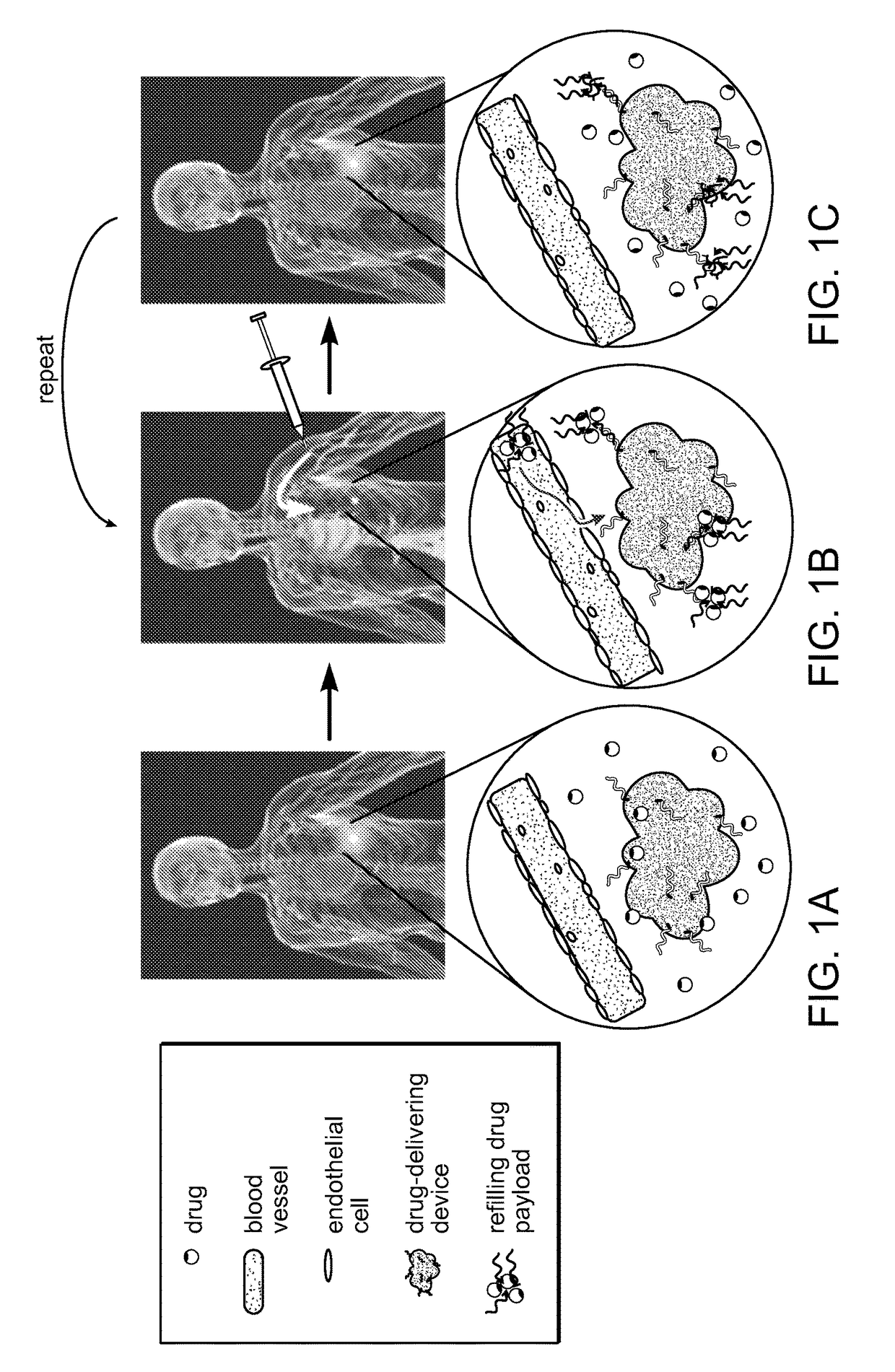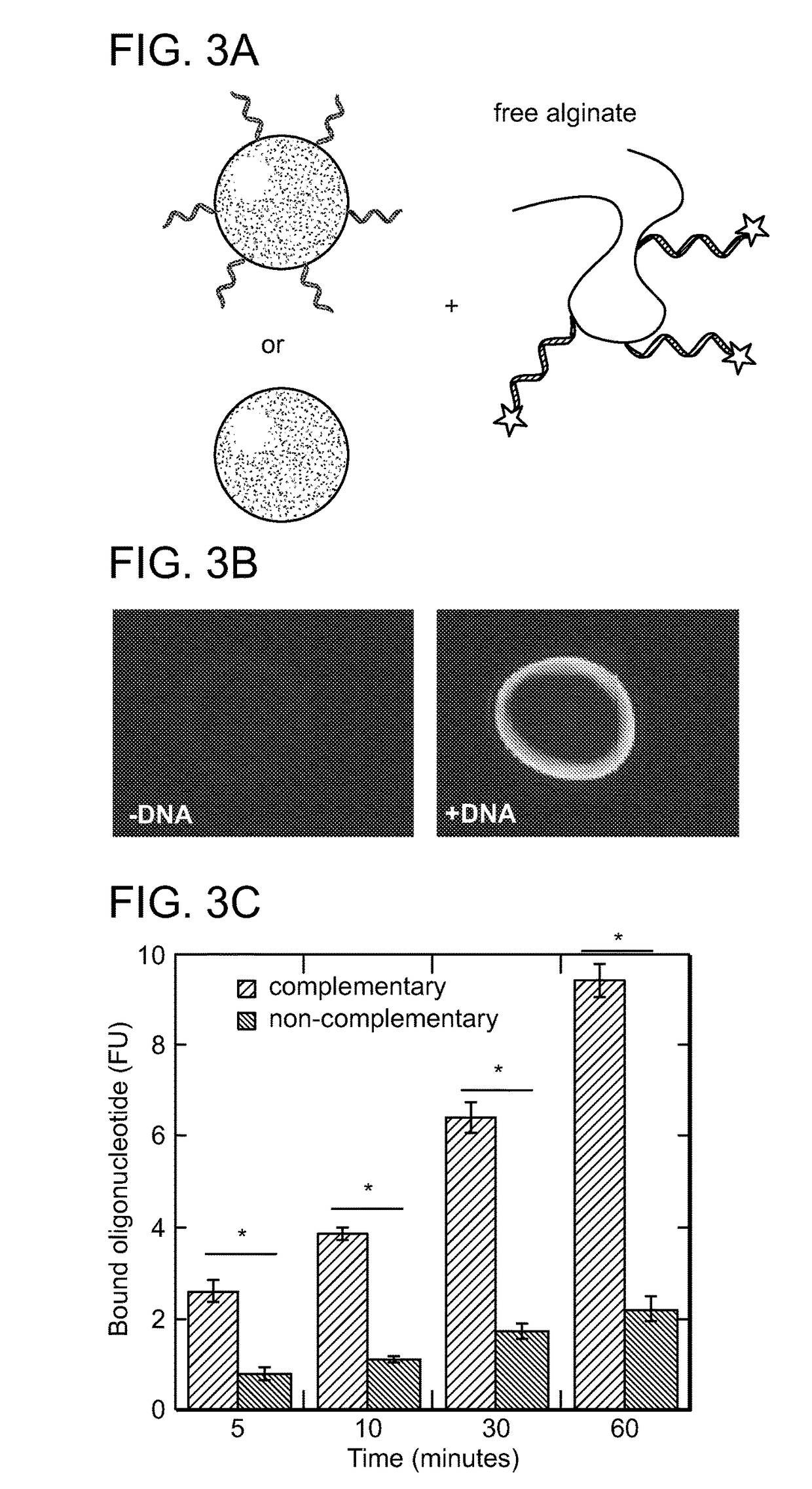Refillable drug delivery devices and methods of use thereof
a drug delivery and refillable technology, applied in the field of refillable drug delivery devices, can solve the problems of no ability to refill and no non-invasive technique to refill these systems, and achieve the effects of reducing the stenosis of blood vessels, preventing future myocardial infarction, and preventing cardiac infarction
- Summary
- Abstract
- Description
- Claims
- Application Information
AI Technical Summary
Benefits of technology
Problems solved by technology
Method used
Image
Examples
example 1
Circulation Time in the Blood
[0376]Efficient blood-based refilling of drug payloads relies on sufficient circulation lifetimes that allow payloads to encounter and bind to the primary device. The circulation time of alginate (285 KDa, 44 nm hydrodynamic radius (Rh)) conjugated to a near-IR probe (FIG. 6A) was analyzed following intravenous (IV) administration to mice. Quantification of fluorescence (FIG. 6B) demonstrated that this alginate remained in circulation for at least 14 days, with a circulatory half-life of about seven days (FIG. 6C). Imaging of individual organs revealed accumulation in the lungs, liver, spleen, and to a lesser extent in the kidneys (FIG. 6D), demonstrating that all of these organs contribute to removal of the circulating alginate from the bloodstream. With a long circulation time, alginate can serve as an efficient intra-vascular drug carrier with the capability of extravasating and interacting with the primary drug delivery device.
example 2
ted Binding of Drug-Surrogates to Alginate Gels In Vitro
[0377]Experiments were performed to determine whether device refilling with drug payloads could be mediated by complementary DNA binding between target calcium-alginate gel and free alginate strands conjugated to a drug payload. DNA (see Table 1 for a list of DNA used) was conjugated by its 3′ end to alginate strands at a ratio of two molecules of DNA coupled per molecule of alginate. The ability of alginate-conjugated DNA to retain nucleic acid binding-activity was then tested. Alginate conjugated to (T)20 oligonucleotides was ionically crosslinked with calcium to form a gel and then was incubated with fluorescently-labeled complementary (A)20 or non-complementary (T)20 oligonucleotides (FIG. 2A) in phosphate buffer with 1 mM calcium chloride. Complementary oligonucleotides bound to the gel surface in a sequence-specific manner while non-complementary oligonucleotides showed little binding (FIGS. 2B-C).
[0378]The ability of DNA...
example 3
NA-Mediated Alginate Homing
[0380]Experiments were performed to determine whether fluorescently-labeled free alginate strands could home in vivo to a target gel through DNA-mediated targeting. DNA was conjugated to alginate through the 3′ end to increase serum exonuclease stability. See, e.g., Shaw J, Kent K, Bird J, Fishback J, & Froehler B (1991) Nucleic acids research 19(4):747-750; Floege J, et al. (1999) The American journal of pathology 154(1):169-179; and Gamper H, et al. (1993) Nucleic acids research 21(1):145-150. A melanoma cancer model was chosen for these studies due to the well established enhanced permeability and retention effect in these tumors, which provides a means for passive accumulation of bloodborne nanoparticles in tumor tissue. See, e.g., Maeda H, Wu J, Sawa T, Matsumura Y, & Hori K (2000) Journal of controlled release: official journal of the Controlled Release Society 65(1-2):271-284. Mice bearing tumors between 10-20 mm3 in size received intra-tumor inject...
PUM
 Login to View More
Login to View More Abstract
Description
Claims
Application Information
 Login to View More
Login to View More - R&D
- Intellectual Property
- Life Sciences
- Materials
- Tech Scout
- Unparalleled Data Quality
- Higher Quality Content
- 60% Fewer Hallucinations
Browse by: Latest US Patents, China's latest patents, Technical Efficacy Thesaurus, Application Domain, Technology Topic, Popular Technical Reports.
© 2025 PatSnap. All rights reserved.Legal|Privacy policy|Modern Slavery Act Transparency Statement|Sitemap|About US| Contact US: help@patsnap.com



